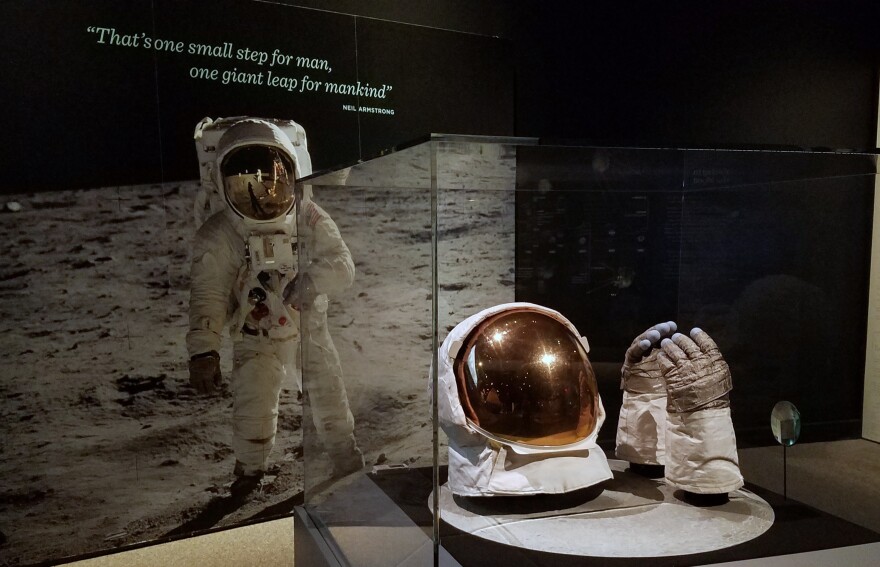It's the only portion of the historic Apollo 11 spacecraft to return to Earth after taking humans to the moon, and it's now in Cincinnati for a limited time.
The Columbia command module is the centerpiece of "Destination Moon: The Apollo 11 Mission," opening Saturday at the Cincinnati Museum Center.
Columbia underwent restoration in 2017, allowing visitors to see it more clearly, says Kathrin Halpern, "Destination Moon" project director with the Smithsonian Traveling Exhibition Service. She says to pay close attention to the side opposite the hatch.
"You'll notice quite a bit of scorching on the back side of the command module and that's because it was the leading edge for re-entry, so you can actually see the history of the mission on the body of the command module."
You can also see the honeycombed steel structure that was impregnated with an epoxy resin heat shield. "Every singe one of those was filled by hand," Halpern points out.
Additionally, she says to look for polka dot-like markings along the bottom of the module. "Those little round marks are actually repairs that were done pre-flight. There was X-raying done of the heat shield to see if there were any kind of anomalies, air pockets, anything like that, and if they found anything those areas were drilled out and replaced to make sure it was a consistent heat shield."

Cincinnati is the fifth and final stop for the Smithsonian exhibit. It includes more than 20 items that flew on the trip to the moon along with models and videos. There is a landing survival kit complete with sunglasses, sunscreen and a machete; a medical kit; one of the lunar sample collection boxes; and the felt-tipped pen Buzz Aldrin used to fix a circuit breaker switch accidentally broken off by his life support backpack. Aldrin's helmet, made famous for reflecting Neil Armstrong as he was taking a photograph of Aldrin, is also included, staged in juxtaposition with the iconic image.
On a special loan for the Cincinnati exhibition is a small piece of fabric from the Wright Flyer that Armstrong carried with him on the mission to the moon.

Halpern says Cincinnati was chosen to host the exhibit for several reasons: it's a Smithsonian partner; it's centrally located for much of the Midwest; it has the necessary temperature and safety controls and infrastructure to support a 13,500 pound artifact; and because of Ohio's rich aviation history.
Plus, Halpern says, "There's this amazing history in Cincinnati with connections to the Armstrong family and the larger Ohio story where so many astronauts have come from Ohio."
Columbia sits on a special transport ring that dates to the Apollo era and was refurbished for the tour. Despite recent renovations to Union Terminal, the loading dock had to be enlarged in order to get Columbia into the museum center.
The handrails on the module are also not original, though they do come from Apollo-era practice modules. NASA removed the hand grips after recovery because they'd been coated with radioactive paint that would fluoresce in case the astronauts needed to see them during an emergency evacuation.

The traveling exhibit marks the first time Columbia has left the National Air and Space Museum since 1976. From Cincinnati it will return to Washington, D.C. to await the 2022 opening of its new space currently under renovation.
"Destination Moon" runs Sept. 28 through Feb. 17, 2020.
NASA this summer commemorated the 50th anniversary of Apollo 11 landing on the moon on July 20, 1969. Buzz Aldrin, Neil Armstrong and Michael Collins made history just hours later as Armstrong and Aldrin became the first two humans to walk on the surface of the moon, with Armstrong uttering the now-immortalized phrase, "That's one small step for [a] man, one giant leap for mankind."
The museum is going all in on the moon theme. "A New Moon Rises" is on display in a neighboring gallery. The photography exhibition features large-scale images of the lunar surface taken from 2009 to 2015 by the Lunar Reconnaissance Orbiter Cameras.
The Omnimax is showing Apollo 11: First Steps Edition during the entire Apollo exhibit run. The film includes "over 11,000 hours of uncatalogued audio recordings of the mission from NASA and the National Archives."
The Cincinnati Museum Center earlier this year opened the Neil Armstrong Space Exploration Gallery, a permanent exhibit featuring Armstrong's inflight jacket, communications cap and the moon rock collected where he took his first steps.



